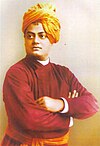Related Research Articles
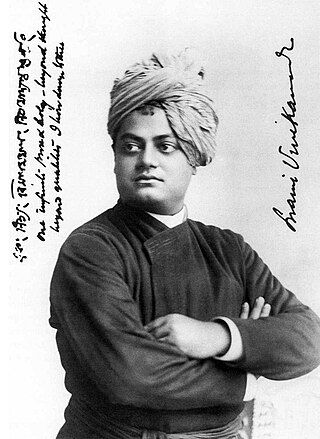
Swami Vivekananda, born Narendranath Datta, was an Indian Hindu monk, philosopher, author, religious teacher, and the chief disciple of the Indian mystic Ramakrishna. He was a key figure in the introduction of Vedanta and Yoga to the Western world, and the Father of modern Indian nationalism who is credited with raising interfaith awareness and bringing Hinduism to the status of a major world religion.
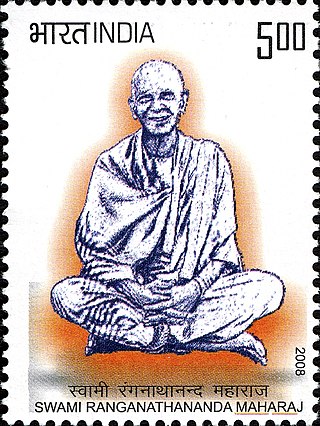
Swami Ranganathananda was a Hindu swami of the Ramakrishna Math order. He served as the 13th president of the Ramakrishna Math and Mission.

Swami Rama Tirtha, also known as Ram Soami, was an Indian teacher of the Hindu philosophy of Vedanta. He was among the first notable teachers of Hinduism to lecture in the United States, travelling there in 1902, preceded by Swami Vivekananda in 1893 and followed by Paramahansa Yogananda in 1920. During his American tours Swami Rama Tirtha spoke frequently on the concept of 'practical Vedanta' and education of Indian youth. He proposed bringing young Indians to American universities and helped establish scholarships for Indian students.
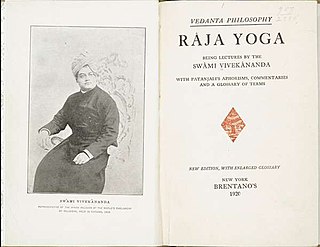
Raja Yoga is a book by Swami Vivekananda about "Raja Yoga", his interpretation of Patanjali's Yoga Sutras adapted for a Western audience. The book was published in July 1896. It became an instant success and was highly influential in the Western understanding of yoga.

Vedanta Societies refer to organizations, groups, or societies formed for the study, practice, and propagation of Vedanta, the culmination of Vedas. More specifically, they "comprise the American arm of the Indian Ramakrishna movement", and refer to branches of the Ramakrishna Order located outside India.

Ramakrishna (1836–1886) is a famous nineteenth-century Indian Bengali Hindu mystic. Born as he was during a social upheaval in Bengal in particular and India in general, Ramakrishna and his movement—Ramakrishna Mission played a leading role in the modern revival of Hinduism in India, and on modern Indian history.
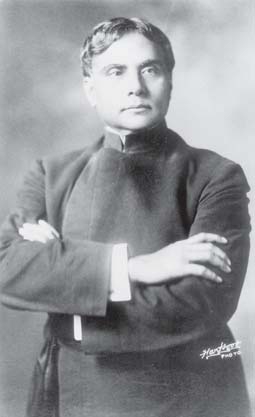
Swami Abhedananda, born Kaliprasad Chandra, was a direct disciple of the 19th century mystic Ramakrishna Paramahansa and the founder of Ramakrishna Vedanta Math. Swami Vivekananda sent him to the West to head the Vedanta Society of New York in 1897, and spread the message of Vedanta, a theme on which he authored several books through his life, and subsequently founded the Ramakrishna Vedanta Math, in Calcutta and Darjeeling.
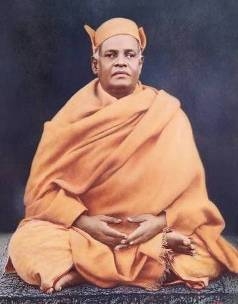
Saradananda, also known as Swami Saradananda, was born as Sarat Chandra Chakravarty in 1865, and was one of the direct monastic disciples of Ramakrishna. He was the first Secretary of the Ramakrishna Math and Ramakrishna Mission, a post which he held until his death in 1927. He established the Udbodhan house in the Bagbazar area of Calcutta, which was built primarily for the stay of Sri Sarada Devi in Calcutta, from where he used to publish the Bengali magazine Udbodhan. There he wrote Sri Sri Ramakrishna Lilaprasanga in Bengali, on the life of Ramakrishna, which was translated into English as Sri Ramakrishna, the Great Master. He is believed to be reincarnation of Saint Peter and he allegedly went into Samadhi when he was in the Saint Peter Church and said that "I remembered my past" and wrote in his diary that "Saint Peter again."

Swami Vivekananda was a Hindu monk from India. His teachings and philosophy are a reinterpretation and synthesis of various strands of Hindu thought, most notably classical yoga and (Advaita) Vedanta, with western esotericism and Universalism. He blended religion with nationalism, and applied this reinterpretation to various aspect's of education, faith, character building as well as social issues pertaining to India. His influence extended also to the west, and he was instrumental in introducing Yoga to the west.
Manilal Chhotalal Parekh (1885-1967), a Gujarati convert to Anglican church, was an Indian Christian theologian, and the founder of Hindu Church of Christ—free from Western influence - opposing Western and institutional nature of Christianity in India.

Josephine MacLeod was an American friend and devotee of Swami Vivekananda. She had a strong attachment to India and was an active participant in the Ramakrishna Vivekananda movement. She was given the nicknames "Tantine" and "Jo Jo" by Vivekananda. She considered Swami Vivekananda to be her friend and helped him with his finances. MacLeod was not a sanyasin, unlike many others such as Sister Nivedita or Sister Christine. She was instrumental in spreading Vivekananda's message on Vedanta in the West. She made many contributions to the initial and the later phases of the development of the order of Ramakrishna and Vivekananda. She was a contributor to many causes espoused by Sister Nivedita, the most famous disciple of Vivekananda, including that of contributing financially towards the development of the Indian National Movement especially in Bengal and elsewhere in India.

Swami Vivekananda (1863–1902) was an Indian Hindu monk and a key figure in the introduction of Indian philosophies of Vedanta and Yoga to the western world. He was one of the most influential philosophers and social reformers in his contemporary India and the most successful and influential missionaries of Vedanta to the Western world. Indian Nobel laureate poet Rabindranath Tagore's suggested to study the works of Vivekananda to understand India. He also told, in Vivekananda there was nothing negative, but everything positive.

Neo-Vedanta, also called Hindu modernism, neo-Hinduism, Global Hinduism and Hindu Universalism, are terms to characterize interpretations of Hinduism that developed in the 19th century. The term "Neo-Vedanta" was coined by German Indologist Paul Hacker, in a pejorative way, to distinguish modern developments from "traditional" Advaita Vedanta.
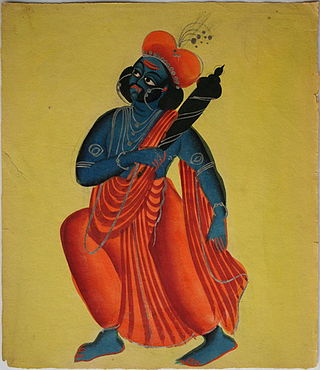
"Arise awake and stop not till the goal is reached." is a slogan popularized in the late 19th century by Indian Hindu monk Swami Vivekananda, who took inspiration in a sloka of Katha Upanishad. It was his message to the world to get out of their hypnotized state of mind. This shloka is the basis of the title of the book The Razor's Edge and the 1946 film and the 1984 film, and also of various music albums in the west by bands like AC/DC, Dave Holland, etc.

Swami Vivekananda, the 19th-century Indian monk, came to Los Angeles, California in 1899 during his second visit to the West. His oratorical skills and presentation of Hindu religious tenets and comparison with other religious beliefs made him a celebrity among a wide spectrum of American audience. Between 1893—1897 and 1899–1902, he traveled widely in the US lecturing on a wide range of subjects and also established Vedanta Centers. There are such centers in many cities in the US, including many centers in California. In 1899, after delivering lectures in New York, he travelled to the western part of the United States and reached Los Angeles via Chicago. He then went on to deliver lectures in California at Oakland, San Francisco and Alameda.

"Buddhism, the Fulfilment of Hinduism" is a lecture delivered by Indian Hindu monk and expounder Swami Vivekananda on 26 September 1893 at the Parliament of the World's Religions in Chicago. In this lecture, he expressed his opinion that "Buddhism was the fulfilment of Hinduism."
Meditation played a very important role in the life and teachings of Swami Vivekananda. He was interested in meditation from his childhood. His master Ramakrishna found him a dhyana - siddha . On 24 December 1892, Vivekananda reached Kanyakumari and meditated for three days on a large rock and took the resolution to dedicate his life to serve humanity. The event is known as the Kanyakumari resolve of 1892. He reportedly also meditated for a long time on the day of his death.

Swami Prakashananda (1874–1927) was a monastic disciple of Vivekananda and a monk of the Ramakrishna Order who played a major role in propagating and promoting the Vedanta philosophy and Vivekananda's message in India and America. He came to the US in 1906 to serve under Trigunatitananda, a direct disciple of Ramakrishna at the Vedanta Society of San Francisco, later renamed as Vedanta Society of Northern California, and later became its president.
Bodhamayananda or Swami Bodhamayananda works for the Ramakrishna Mission. He is the director of Vivekananda Institute of Human Excellence, Hyderabad, and the Coordinator of the Personality Development Project of Sri Ramakrishna Math, Chennai.
Swami Akhilananda was born on 25 February 1894 as Nirode Chandra Sanyal in Netrakona in British India.
References
- 1 2 3 Jongeneel 2009, p. 192.
- 1 2 3 4 Bhide 2008, p. 39.
- ↑ Burke 1973, p. 204.
- ↑ Arangassery 1999, p. 22.
- ↑ Vivekananda 2015, p. 552.
- 1 2 "Christ the Messenger: The Complete Text from the booklet Christ the Messenger". Vedanta Press and catalog. Retrieved 27 December 2015.
- 1 2 Schouten 2008, p. 92.
- 1 2 3 Saraf 2012, p. 128.
- ↑ Vivekananda 2015, pp. 551–58.
- ↑ Vivekananda 2015, pp. 551–558.
- ↑ Schouten 2008, p. 94.
- ↑ Vivekananda, Swami (1900). Christ, the messenger: lecture delivered by Swami Vivekananda at Los Angeles, California, 1900. The Vedanta Centre. pp. 4–11.
- ↑ Schouten 2008, p. 93.
